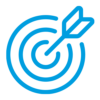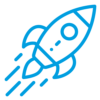Enterprise Transformation
Success Case
Client
Compliance Resource Provider
Number of Employees
100 – 200
Solution
Enterprise Transformation
Lead Netminder
Jaqueline Blackman

Client Overview

Client Overview
What is the client’s business, industry, and product or service? Who is the client’s target customer?
Our client is a non-profit technology organization that provides compliance and licensing information for insurance professionals. As a whole, the insurance industry is highly-regulated, and our client must adhere to strict compliance policies themselves.
Their mission is to provide a single source reference point with business rules and uniformed data to help ensure regulators, the insurance industry, and consumers are protected.

Challenge

Challenge
What challenge or initiative was the client looking to address?
As part of a multi-year strategic plan, the client’s leadership laid out a long-term vision for the future growth and evolution of IT through these high-level objectives:
- Increase organizational agility and ability to adapt to a changing environment
- Strengthen and refine the core business
- Adopt a more market-centric and customer-focused experience
- Strengthen the working relationship with the Board of Directors and parent company
In addition to these organizational growth plans and objectives, the client had already attempted to implement agile without success. These results led to partially trained individuals, a negative perception of agile among team members, and an overall disconnected team environment.

Target Audience

Target Audience
What was the participant profile? What team, department, or area did they people belong to? How does this team, department, or area fit into the organizational structure?
Our ultimate audience was the people working in the IT department. However, to ensure the transformation was sustainable, we worked with three profiles in the organization:
- Leadership: Those who are driving the initiative and are ultimately accountable.
- Change Agents: Those responsible for the implementation.
- Team Members: Those making the changes in how they work.

Objectives
What objectives was the client looking to achieve? Were there high-level initiatives or goals that motivated the client?
After experiencing a failed agile implementation, our Lead Expert and the client change agents identified some specific challenges, including:
- Individuals were trained as Scrum Masters but had no agile experience.
- Teams understood the concept of agile but weren’t sure how to transition their current backlog.
- Agile ceremonies were interpreted inconsistently across teams.
- Teams weren’t empowered and didn’t feel confident making decisions.
- Teams considered the rest of the organization to be waterfall.
- Unplanned work was being pushed into the teams’ queue and overriding sprint planning.
- Management expected it all to be done, regardless of the teams’ estimated velocity.

Solution
What solution did we propose to accomplish their objectives? How was the program structured? What were the contents of the program? What was Netmind’s role in the solution?
Our Enterprise Transformation solution was used to properly implement an agile transformation and help the client to overcome the challenges left in the wake of their former, failed attempt.
Startup
In-depth assessment by our experts with team interviews, observation, and artifact review.
Ideation
Workshops and training on agile practices and proposed organizational model adjustments to establish a baseline understanding and set expectations with Leadership.
Framework MVP
Facilitated collaborative work sessions to develop a framework for the working agreement, team organization, and management model.
Pilots
Comprehensive training delivery through Course Based Improvement for all team members to understand what agile success looks like, their responsibilities, and “how to” perform as an agile team.
Scale
Scaled agile by using SAFe as a baseline to establish a multi-team, lightweight framework.
Framework Growth
On-going assessments to determine team progress and identify new areas of concern to be addressed immediately through mentoring and long-term though framework improvements.
Culture Transformation
A guild framework was established to ensure in-house cross-functional knowledge sharing and create a culture of continuous learning and development.

Outcomes
What value did we deliver to the client? Which problems did we solve? How has the solution changed the client’s way of working?
Startup
Discovered new obstacles, validated previously identified objectives, and determined a plan for organizing and managing the transformation project.
Ideation
Identified the AS IS situation, defined the TO BE vision, and started to pinpoint the Agile adoption action plan.
Framework MVP
Developed the initial Agile Framework to be implemented and a course for teams on how to apply, implement, and use it.
Pilots
Established a baseline for working as cross-functional teams, built a Kanban board with 2 week-planning cycles, and demonstrated application of the organizational framework.
Scale
Gained understanding of how to evaluate SAFe tools and approaches and developed a 2-phased SAFe implementation plan that was based on Pilot team success and experience.
Framework Growth
Custom workshops helped address team over-commitment, lack of empowerment, role re-alignment, and interdependence within the program.
Culture Transformation
Team configuration standards were established, individuals learned how to be more cross-functional, and a train-the-trainer coaching program was established to improve consistency across roles and domains.

Business Impact
How was the real impact on business be measured? To what degree did the targeted outcomes occur as a result of this initiative?
The client has cross-functional, self-directed, vertically-aligned teams who are now seeing the intended benefits of agile. Additionally, teams have the tools to continuously improve through strategic milestones that include coaching and touch points for accountability.
As a part of the client’s continuous improvement, we are working together to mine the data from completed sprints to help baseline their Agile KPIs. This allows upper management transparency and awareness of the planned versus actual progress, the value delivered, and the capacity.

Next Steps
What future goals does the client now wish to accomplish? How will the expand on what they have learned/implemented?
Ongoing efforts include identifying a unique way to measure success in an environment with multiple product owners and creating a value management framework which incorporates enterprise business analysts and epic owners.
As sprints are completed, Netmind continues to play a role by working with the teams to use their data and metrics to establish a KPI and 360° review framework that reinforces agile values. Continuous learning through their Guilds and Communities of Practice helps ensure an engaged and progressive-thinking pool of talent.

The labs/practicals reinforce the information more than lecturing and were very helpful. Remarkable opportunity to internalize agile information on the one hand, and to get to know people on the other. Very useful in reinforcing, making stick, in theory. I liked the dynamic nature of the labs, introducing new information while “in flight”, just as though it was a real-life scenario. Jacqueline was an excellent instructor.

Training was excellent. Gave a good knowledge of agile practices, term, and different ways of implementing and getting buy in from staff and senior management.

Since attending class, I have been able to apply the elicitation methods to deal with the clients during our effort to reduce the number of issues reported. This has helped provide more details to QA and developers on what the client is having specific issues with. This was a good class with a great instructor and really helpful materials. Thank you.
